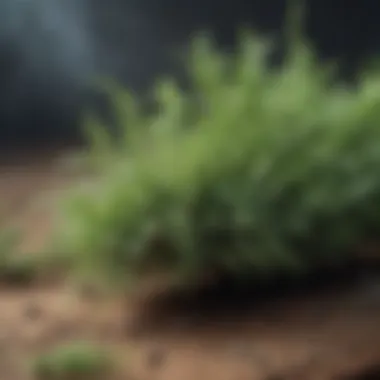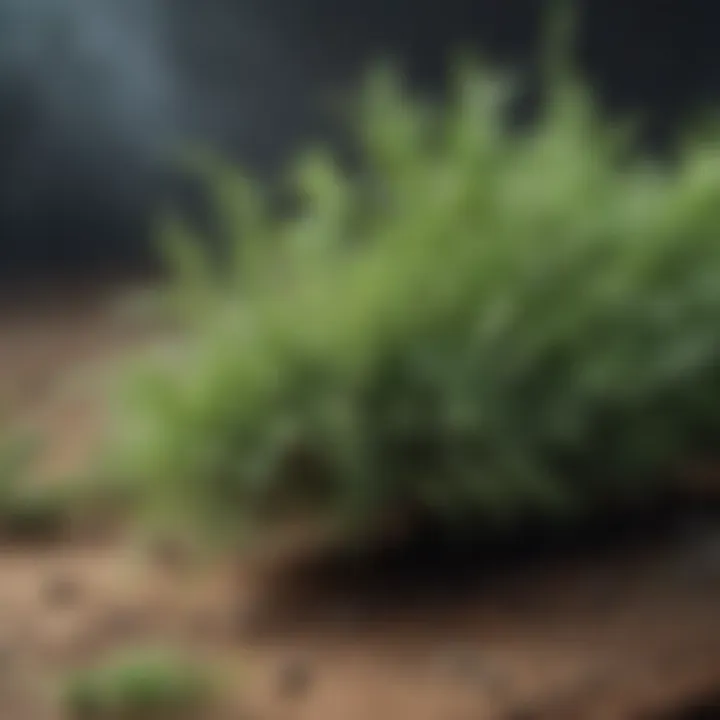Unveiling the Remarkable Benefits of Wormwood for Parasites


Research Overview
At the core of combating parasite infections lies the potential benefits of wormwood, an herbal remedy with a rich historical background. From ancient times to modern applications, wormwood has garnered attention for its purported effectiveness against parasites. This section will delve into the nuances of using wormwood as a natural remedy for parasitic infections, offering insights into its historical significance and how it is utilized in contemporary times.
Health Implications
Exploring the health implications of incorporating wormwood into parasite treatment regimens unveils a multifaceted approach to mitigating parasitic infections naturally. By discussing the potential benefits and risks associated with wormwood usage, readers can gain a holistic understanding of its effects on health. Additionally, examples will be provided to illustrate how wormwood can be integrated into daily health routines to combat parasites effectively.
Well-being Strategies
This section will provide practical strategies derived from research on wormwood, offering readers actionable advice on enhancing their well-being through the incorporation of this herbal remedy. Practical tips will be presented to guide individuals on implementing positive changes in their lifestyle to support parasite treatment using wormwood. Furthermore, personal stories or case studies will be shared to underscore the efficacy of these strategies in real-life scenarios.
Expert Insights
An in-depth analysis of expert opinions on the research findings related to wormwood and its benefits in parasite treatment will be presented in this section. Engaging in a Q&A session with a relevant expert in the field will offer readers a comprehensive understanding of the application and effectiveness of wormwood in combating parasitic infections.
Introduction to Wormwood
In this segment, we delve into the significance of wormwood in combating parasitic infections. Wormwood, a herb known for its potent antiparasitic properties, has been utilized since ancient times for its therapeutic benefits. Its effectiveness in eliminating parasites and its role in traditional medicine practices make it a subject of interest in modern healthcare. By exploring wormwood's historical uses, botanical characteristics, and its impact on parasite species, this article aims to provide a comprehensive guide to utilizing wormwood as a natural remedy.
Historical Significance
The Ancient Uses of Wormwood
One of the notable aspects of wormwood is its ancient medicinal uses dating back centuries. It has been a key component in traditional medicine for addressing various health issues, especially parasitic infections. The unique characteristic of wormwood lies in its ability to target a wide range of parasites, making it a popular choice in historical remedies. Despite the effectiveness, historical uses also highlight the importance of proper dosage and administration to maximize its benefits in fighting parasites.
Wormwood in Traditional Medicine Practices
Wormwood's integration into traditional medicine practices further reinforces its significance in parasite treatment. The inclusion of wormwood in diverse medicinal formulations underscores its versatile nature and adaptability as a therapeutic agent. Its prominence in traditional medicine as a natural antiparasitic remedy underscores the trust and reliance placed upon this herb for centuries. However, discerning the optimal use of wormwood in traditional practices is essential to ensure its efficacy and safety in combating parasitic infections.
Botanical Overview
Characteristics of Wormwood Plant


Exploring the botanical characteristics of the wormwood plant sheds light on its unique attributes for combating parasites. From its distinct bitter taste to its aromatic properties, wormwood possesses key characteristics that enhance its antiparasitic efficacy. The bitter taste of wormwood is indicative of its potent medicinal properties, particularly in expelling parasites from the body. Understanding these botanical traits is crucial for optimizing the therapeutic benefits of wormwood in parasite treatment.
Common Varieties of Wormwood
The existence of various wormwood varieties enriches the spectrum of antiparasitic treatments available. Different wormwood strains exhibit specific attributes that cater to diverse parasite species, offering a tailored approach to parasite eradication. Each variety of wormwood carries its distinct advantages, contributing to the comprehensive arsenal of natural remedies against parasitic infections. Selecting the appropriate wormwood variety aligns with the targeted parasite species, optimizing the efficacy of treatment outcomes.
Understanding Parasitic Infections
Understanding parasitic infections is crucial in comprehending the benefits of using wormwood for treating parasites. Parasites, such as protozoa, helminths, and ectoparasites, can cause various health issues in humans. By understanding the types of parasites and the symptoms they cause, individuals can identify and address parasitic infections promptly. This knowledge is essential for effectively utilizing wormwood as a natural remedy.
Types of Parasites
-#### Protozoa Protozoa are single-celled organisms that can lead to parasitic infections in humans. These microscopic organisms can enter the body through contaminated food or water, causing diseases like malaria and giardiasis. While protozoa have diverse species, each with unique characteristics, they share the ability to thrive and multiply in the host's body, causing various health complications.
-#### Helminths Helminths are parasitic worms that infect the gastrointestinal tract, blood, or tissues. These multicellular parasites can cause diseases such as tapeworm infections and schistosomiasis. The key characteristic of helminths is their complex life cycles, which often involve multiple hosts. While helminth infections can be challenging to eradicate, understanding their life cycles is crucial for effective treatment using wormwood.
-#### Ectoparasites Ectoparasites are external parasites that live on the surface of the host's body, such as fleas and lice. These parasites feed on the host's blood or skin, causing itching, irritation, and potential transmission of diseases. While ectoparasites do not reside inside the body like protozoa and helminths, they can still pose significant health risks and discomfort to the host.
Symptoms and Complications
-#### Common Symptoms of Parasitic Infections Parasitic infections can manifest through various symptoms, including abdominal pain, diarrhea, fatigue, and weight loss. Understanding these common symptoms is essential for early detection and prompt treatment. Recognizing the signs of parasitic infections can help individuals seek appropriate medical interventions, including the use of wormwood as a natural antiparasitic remedy.
-#### Potential Complications If left untreated, parasitic infections can lead to severe complications, such as malnutrition, anemia, and organ damage. Some parasites have the potential to cause chronic health issues if not adequately managed. By recognizing the potential complications of parasitic infections, individuals can take proactive measures to address these issues and prevent long-term health consequences.
Benefits of Wormwood for Parasites
Antiparasitic Properties
Artemisinin: The Active Compound
Delving into the specific aspect of Artemisinin: The Active Compound reveals a key characteristic of wormwood's antiparasitic effectiveness. Artemisinin is the fundamental bioactive compound in wormwood responsible for its antiparasitic qualities. This unique feature of Artemisinin makes it a popular choice in addressing parasitic infections due to its potent properties in targeting parasites effectively. While discussing Artemisinin, its advantages in parasite combat are highlighted, showcasing why it is an essential component in this article's exploration of the benefits of wormwood for parasites.
Effects on Different Parasite Species
The effects of wormwood on different parasite species play a crucial role in understanding its overall efficacy. Wormwood exhibits a spectrum of antiparasitic effects on various parasite species, making it a versatile solution for a wide range of parasitic infections. By highlighting the key characteristics of how wormwood interacts with different parasite species, its popularity as a beneficial antiparasitic agent becomes evident. Exploring the unique features of wormwood's effects on different parasite species helps shed light on its advantages and potential disadvantages, providing essential insights for this article's discussion.


Clinical Studies and Research
In shedding light on the efficacy of wormwood extracts, this section delves into the specific aspects that contribute to its antiparasitic properties. By examining the research on wormwood extracts' effectiveness in combating parasites, the key characteristic of their efficacy is highlighted. The discussion surrounding the beneficial and possibly controversial nature of using wormwood extracts in par challenges prevalent in this article. Additionally, by exploring comparative studies on wormwood's antiparasitic efficacy, readers gain a deeper understanding of how this herbal remedy fares against traditional treatments. Comparing wormwood's efficacy against other methods provides a nuanced perspective on its advantages and potential drawbacks within the realm of parasite treatment.
Administration and Dosage
Administering and determining the correct dosage is crucial when considering the benefits of wormwood for parasites. The effectiveness of wormwood in combating parasitic infections is directly linked to the proper administration and dosage. Ensuring the correct amount of wormwood is consumed is essential for maximizing its antiparasitic properties and minimizing potential side effects. By understanding how to correctly administer and dose wormwood, individuals can harness its full potential in addressing parasite infections.
Dosage Guidelines
Recommended Dosage for Adults
When it comes to adult dosages of wormwood, a typical recommendation is to consume between 200-400 milligrams of wormwood extract two to three times daily for parasitic infections. This dosage range has shown efficacy in targeting a variety of parasites without causing significant adverse effects. The recommended dosage for adults is carefully calculated based on the individual's weight, severity of the infection, and overall health status. Adhering to the advised adult dosage regimen ensures that the antiparasitic properties of wormwood are optimally utilized, leading to effective parasite elimination.
Considerations for Children
Unlike adults, children require lower dosages of wormwood due to their smaller size and developing bodies. It is recommended to consult with a healthcare provider or herbalist to determine the appropriate dosage for children based on their age, weight, and health condition. The dosage for children should be carefully supervised to prevent any potential side effects or toxicity. Considering children's unique physiology and susceptibility, administering wormwood to children should be done under professional guidance to ensure safe and effective parasite treatment.
Methods of Administration
Tinctures
Tinctures are concentrated liquid extracts of wormwood that offer a convenient and potent way to administer the herb. They are typically consumed by diluting a few drops in water or juice. This method allows for easy dosage adjustment and rapid absorption of wormwood's antiparasitic components into the bloodstream. Using tinctures for wormwood administration provides a controlled and efficient way to target parasites in the body.
Capsules
Wormwood capsules contain powdered or liquid extract of the herb enclosed in a gelatin or vegetarian casing. Capsules offer a convenient and tasteless option for consuming wormwood, making it easier for individuals to adhere to their dosage regimen. The encapsulated form ensures precise dosing, eliminates the strong flavor of wormwood, and enhances the portability and storage of the herb for parasite treatment purposes.
Decoctions
Decoctions involve simmering wormwood plant parts in water to extract its beneficial properties. The resulting liquid is then consumed as a tea or tonic. Decoctions offer a traditional and holistic method of administering wormwood, allowing for a gentler absorption of its antiparasitic compounds. This method is ideal for individuals who prefer a milder taste and a more soothing approach to parasite treatment.
Potential Side Effects and Considerations
In this section of the article, we delve into the crucial aspect of potential side effects and considerations when using wormwood for parasitic infections. Understanding the possible drawbacks and precautions is essential for anyone looking to explore the benefits of this ancient remedy. By highlighting the potential side effects, readers can make informed decisions about incorporating wormwood into their treatment regimen.


Side Effects of Wormwood
Digestive Upset
The specific aspect of digestive upset associated with wormwood is a notable consideration for individuals interested in its antiparasitic properties. Digestive upset may include symptoms such as nausea, stomach pain, or diarrhea. Despite these discomforts, this reaction demonstrates the potent effects of wormwood on the digestive system, effectively targeting parasites residing in the gut. While disruptive, the digestive upset serves as a marker of the herb's bioactivity, indicating its potential efficacy in combating parasitic infections.
Neurological Effects
Exploring the neurological effects of wormwood provides insight into its comprehensive impact on the body when used as an antiparasitic remedy. These effects may include dizziness, headache, or confusion in some individuals. By affecting the nervous system, wormwood showcases its intricate interactions within the body, potentially influencing parasites that have neurologically-driven lifecycles. Understanding these neurological effects enables a nuanced approach to utilizing wormwood, considering both its benefits and limitations for individuals seeking natural parasite treatment.
Precautions and Contraindications
In this segment, we address the important precautions and contraindications associated with wormwood usage for parasitic infections. Being aware of potential drug interactions and populations that should avoid wormwood is paramount for ensuring the safe and effective application of this herbal remedy in parasite treatment protocols.
Drug Interactions
Discussing the realm of drug interactions concerning wormwood sheds light on the complexities of integrating this botanical treatment with conventional medications. Certain drugs may interact with wormwood, altering their effectiveness or causing unforeseen reactions. Recognizing these potential interactions is crucial for individuals managing parasitic infections alongside other treatments, preventing any adverse outcomes or diminished therapeutic benefits.
Special Populations to Avoid
Highlighting specific populations that should avoid wormwood usage delineates the necessity of tailored recommendations based on individual health profiles. Pregnant or breastfeeding women, children, and individuals with certain medical conditions may need to refrain from using wormwood due to potential risks or contraindications. By acknowledging these restrictions, practitioners can offer personalized advice, safeguarding vulnerable groups from any adverse effects associated with wormwood treatment.
Conclusion
In the intricate expedition through the landscape of the benefits of Wormwood for parasites, the conclusion becomes the nucleus wherein all insights converge. By traversing the historical significance of Wormwood, understanding its botanical essence, and unraveling its antiparasitic potential, the conclusion shelters a culmination that encapsulates the essence of Wormwood's role in combating parasitic infections. By delineating the pragmatic application of Wormwood as a natural remedy, the significance of concluding with discerning considerations and future implications unveils the horizon of possibilities in parasitic infection management.
Summary of Key Points
Benefits of Wormwood for Parasites
Delving into the expanse of Wormwood's benefits for parasites unveils a tapestry of efficacy. Artemisinin emerges as the pivotal protagonist, wielding potent antiparasitic properties that underscore its valor in combatting diverse parasite species. The distinctiveness of Wormwood lies in its multidimensional effects on parasites, orchestrating a symphony of bioactivity that thwarts parasitic invasions with precision. The nuanced superiority of Wormwood as a natural remedy embellishes its stature as a pragmatic choice for parasitic infections, offering a holistic approach to parasite management that resonates with the essence of nature.
Considerations and Precautions
Navigating the labyrinth of considerations and precautions surrounding Wormwood illuminates a pragmatism essential for its judicious utilization. From mitigating digestive upsets to acknowledging potential neurological effects, the spectrum of side effects casts a prudent shadow over the therapeutic realm of Wormwood. Envisioning the precautionary measures and contraindications underscores the imperative of an informed approach towards integrating Wormwood into parasitic infection management, instilling a sense of vigilance necessary for optimizing its therapeutic benefits.
Future Research Directions
Potential Applications in Modern Medicine
Tracing the trajectory of Wormwood's integration into modern medicine unravels a realm of potential applications brimming with promise. The unique pharmacological profile of Wormwood accentuates its relevance as an adjunctive therapy in contemporary medical paradigms, offering a synergistic ally in combating parasitic infections. The imperative of further exploration into Wormwood's applications burgeons with the beacon of innovation, shedding light on a future where ancient remedies seamlessly merge with modern therapeutic landscapes to redefine the contours of parasitic infection management.



